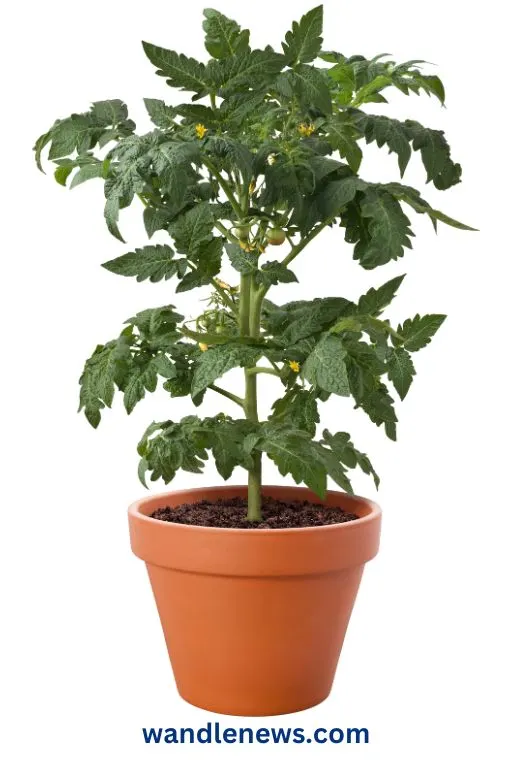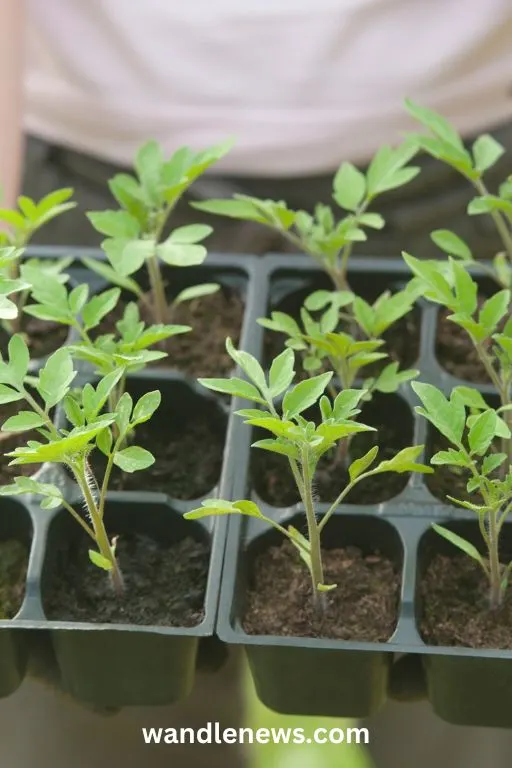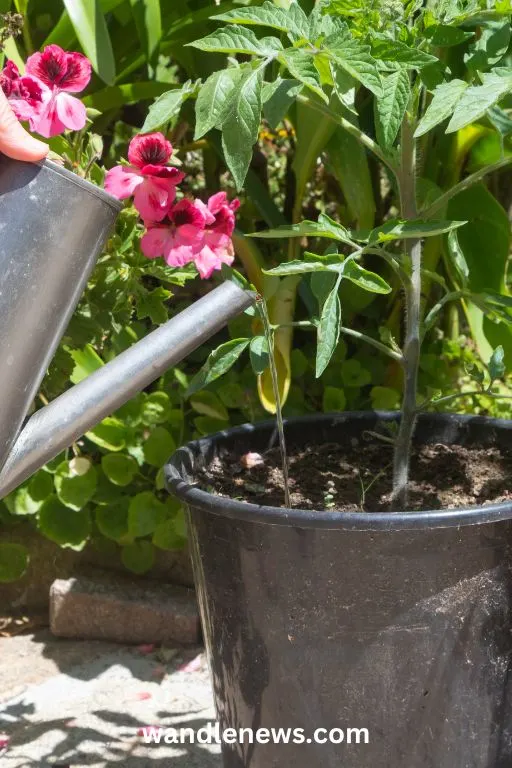Tomatoes are a favourite among gardeners for their versatility in various dishes, from salads to sauces. The flavour of homegrown tomatoes far surpasses store-bought ones, making the effort to cultivate your own tomatoes highly rewarding!
Even if your gardening space is limited to a small balcony, porch, or patio, you can still grow your own tomato plants in pots. This article provides a comprehensive guide on how to grow tomatoes in pots, from selecting the right types and containers, to caring for your plants and addressing common problems.

A Guide on How to Grow Big Tomatoes in Pots
- Best Varieties for Growing Big Tomatoes in Pots
- Best Potting Soil for Tomatoes
- Planting Tomato Seeds for Success
- Transplanting your Tomato Plants to Pots
- When to Add Support
- Choosing the Perfect Spot for Your Container Tomatoes
- Mastering the Art of Tomato Watering
- Fertilising for Healthy Growth
- Common Problems and How to Address Them
Best Varieties for Growing Big Tomatoes in Pots
If you’re aiming to grow impressively large tomatoes in pots, selecting the right tomato variety is essential. Here, we’ll focus on varieties known for producing substantial, beefsteak-sized fruits in container gardens. These tomatoes are not only delicious but also visually striking.
- Brandywine (Sudduth’s Strain): Brandywine tomatoes are legendary for their superb flavour and large, beefsteak-shaped fruit. The Sudduth’s Strain is a cherished heirloom known for producing some of the biggest and most flavourful tomatoes. Choose large containers to accommodate these giants.
- Beefsteak (‘Beefmaster’ or ‘Big Beef’): True to their name, Beefsteak tomatoes are renowned for their hefty size and robust flavour. Varieties like ‘Beefmaster’ or ‘Big Beef’ thrive in pots, provided you select containers with ample room for their substantial fruit.
- Mortgage Lifter: This heirloom tomato has a fascinating history and produces large, pinkish-red fruits that can weigh up to two pounds.
- Aunt Ruby’s German Green: If you’re seeking large, green tomatoes with a sweet and slightly tart flavour, Aunt Ruby’s German Green is an excellent choice. Though these tomatoes are often associated with their colour.
- Pineapple: Pineapple tomatoes are known for their bi-colour, red and yellow flesh, and their size can be astonishing. For a unique addition to your container garden, choose Pineapple tomatoes and provide a spacious pot to accommodate their sizeable fruit.
- Oxheart: Oxheart tomatoes are heart-shaped and can reach substantial sizes, making them a great option for tomato enthusiasts looking to grow large fruit in pots.
- Delicious: True to its name, the ‘Delicious’ tomato variety produces large, meaty fruits that are perfect for slicing. These giants can be grown successfully in larger containers on your balcony or patio.
- Cherokee Purple: While not the largest in terms of weight, Cherokee Purple tomatoes are known for their sizeable, purple-tinged fruits and rich, smoky flavour. They are a favourite among heirloom tomato enthusiasts and can be grown in spacious containers.
Best Potting Soil for Tomatoes
To ensure your tomato plants thrive, it’s crucial to choose the correct potting mix and containers with good drainage. Garden soil is unsuitable, as it may compact and harbour soil-borne diseases. Opt for a high-quality, all-purpose potting mix containing peat moss, which enhances drainage.
Consider using plastic pots, which are lightweight and durable, or fabric pots for their good drainage. Ensure containers have drainage holes at the bottom to prevent excess water accumulation.

Planting Tomato Seeds for Success
Starting your tomato journey from seed is a rewarding experience. Begin by planting your tomato seeds in small pots or trays filled with fresh potting mix. Ensure the timing aligns with your local climate, typically 6-8 weeks before the last expected frost date.

Transplanting your Tomato Plants to Pots
Whether you’ve procured robust tomato seedlings from a nursery or nurtured your chosen variety from seed, the time will come to transplant these young seedlings into their final, roomy growing containers.
Conventional wisdom in potting usually advises keeping the soil level consistent when transplanting, preserving ample space beneath the soil for the roots to stretch downward. However, when it comes to tomato plants, a unique approach is required. These remarkable plants possess the remarkable ability to sprout additional roots along the submerged portions of their stems. Therefore, it is highly recommended to plant them deeply to foster a vigorous root system.
When transplanting tomato seedlings, begin by gently removing the lowermost sets of leaves. Then, position the seedling so that it is buried approximately halfway into the container. This strategy accomplishes two essential objectives: it provides adequate space beneath the seedling for root expansion downward and encourages the growth of additional roots towards the upper portion of the pot.
Do not fret if the plant appears significantly smaller than when it initially sprouted. With a few leaves above the soil line and a generously sized container, your tomato plant will quickly flourish and fill out, embarking on its journey to produce succulent, sun-ripened tomatoes.

When to Add Support
When it comes to growing tomatoes in containers, the size and type of tomato variety you choose will determine whether you need to provide support. Shorter tomato varieties, especially the compact ones, often stand tall and sturdy on their own, eliminating the need for additional support.
However, if you’ve opted for taller tomato varieties, you’ll want to ensure they have the support they need. Supporting your tomato plants serves several essential purposes. It keeps the stems upright and off the ground, preventing potential issues like soil-borne diseases or pest damage. Additionally, robust support structures help distribute the weight of the large, juicy fruits, preventing stems from snapping under the pressure.
There are two primary methods for supporting your tomato plants: staking and caging. Your choice between these methods will depend on the variety you’ve selected and your specific requirements. It’s a good practice to implement your chosen support structure shortly after planting to avoid disrupting the roots once they’ve established themselves at the edges of the container.
By providing the right support for your tomato plants, you ensure they grow upright, stay healthy, and can handle the weight of those delicious, sun-ripened fruits. Whether it’s staking or caging, a little early planning can go a long way in helping your tomatoes thrive in your container garden.

Choosing the Perfect Spot for Your Container Tomatoes
Tomato plants are sun worshippers, and they crave ample sunlight. A minimum of 6 hours of full sunlight daily is essential for their well-being. Without this vital ingredient, your plants won’t reach their full potential or muster the energy needed for fruit production. The beauty of container gardening is that if your tomato plants signal a lack of sunlight, you can simply relocate them to a sunnier spot.
Additionally, tomato plants are sensitive to temperature, thriving in warmth while recoiling from the cold. Fortunately, container-grown tomatoes offer you a lifeline in the face of unexpected chilly weather. You can easily safeguard your potted treasures by bringing them indoors overnight and then returning them to their sunny abode during the day.
By prioritising sunlight and temperature considerations, you’ll set the stage for flourishing container-grown tomatoes that bask in the glow of the sun and reward you with a bountiful harvest.

Mastering the Art of Tomato Watering
Tomatoes are thirsty creatures, with around 95% of their composition being water. This makes watering a critical factor in the success of your tomato plants, especially when it comes to the juicy, flavourful fruits every gardener anticipates.
However, there’s a delicate balance to strike when it comes to watering tomatoes. Underwatering can lead to wilted plants, while overwatering can result in dreaded root rot. Inconsistencies in watering can even cause the fruits to crack, which is far from ideal.
This challenge becomes more pronounced when you’re cultivating tomatoes in containers. Container soil tends to dry out much faster than the earth in outdoor garden beds. Excess water may escape through drainage holes, leaving less for the roots to absorb. Furthermore, the sun’s heat accelerates soil drying, a process that can be intensified by strong winds.
To ensure your tomato plants thrive, you must provide them with an adequate and consistent water supply. In container gardening, this often translates to more frequent watering compared to traditional backyard gardening. Here are some guidelines to help you navigate the watering needs of your container-grown tomatoes:
- Regular Checks: Make it a habit to inspect the soil in your containers daily, especially during the scorching days of summer.
- Timing Matters: Watering in the morning is generally ideal. This allows your plants to absorb moisture, fortifying them against the heat and sun throughout the day.
- Water with Care: Only water when necessary. Stick your finger into the soil, and if it feels dry an inch or two down, it’s time to water. Avoid shallow, frequent watering, as this can encourage shallow root development and weaker plants.
- Be Mindful of Container Size: Larger pots hold more soil volume and water, requiring less frequent watering. Consider this when selecting container sizes for your tomatoes.
- Extra Protection: In extremely hot and dry conditions, you may need to water your container-grown tomatoes twice a day. Keep an eye on weather patterns to adjust your watering schedule accordingly.

Fertilising for Healthy Growth
Tomatoes are known as heavy feeders, meaning they require ample nutrients for their rapid growth and abundant fruit production. Since container-grown tomatoes may leach nutrients faster due to frequent watering, it’s crucial to fertilise appropriately.
At the time of planting, incorporate a balanced slow-release fertiliser into the soil, following package instructions. This provides a steady supply of essential nutrients. As the plants begin to flower, supplement with a liquid fertiliser every two weeks. Options like fish emulsion, seaweed, or compost tea work well. This regular feeding schedule ensures your plants have the nutrients they need for robust growth and the development of those sought-after big, juicy tomatoes.

Common Problems and How to Address Them
- Overwatering: Allow soil to dry between waterings and check for proper drainage.
- Underwatering: Maintain consistent soil moisture, especially during warm temperatures.
- Container Size: Transplant to larger pots if roots become crowded.
- Sunlight: Ensure 6 to 8 hours of sunlight throughout the growing season.
- Soil-Borne Diseases: Use fresh potting soil to prevent disease issues.
FAQs on Growing Big Tomatoes in Pots
How can I prevent blossom end rot in my potted tomato plants?
To prevent blossom end rot, ensure consistent watering, maintain proper calcium levels in the soil, and avoid over-fertilisation.
How much sunlight do my potted tomatoes need?
Potted tomatoes thrive in full sun, requiring at least 6 hours of direct sunlight daily for optimal growth and fruit production.
When should I transplant my tomato seedlings into larger containers?
Transplant tomato seedlings into larger containers when they have grown a few sets of true leaves and the main stem is sturdy.
Is it a good idea to grow only one tomato plant in a large container?
Yes, growing a single plant in a large container ensures it has ample space, nutrients, and room for root development.
How do I determine the right pot size for my tomato plants?
A good rule of thumb is to use containers that can hold at least 5 gallons of soil for each tomato plant.
Are self-watering containers suitable for growing tomatoes in small spaces?
Yes, self-watering containers are a great option for small spaces, providing consistent moisture to your tomato plants.
How often should I water my potted tomatoes?
Water your potted tomatoes when the soil is dry to the touch about 2 inches below the surface. This may require daily watering, especially in warm weather.
What is the importance of burying the stem when transplanting tomato seedlings?
Burying the stem encourages the development of additional roots, resulting in a healthier and more productive tomato plant.
Where should I water my container-grown tomatoes?
Water around the base of the plants to avoid splashing foliage, which can lead to diseases.
Should I use a layer of mulch around my potted tomato plants?
Yes, mulch, such as straw or shredded bark, can help retain moisture, suppress weeds, and keep the roots cool in containers.

Gardening Posts
I hope you found this post about how to grow big tomatoes in pots helpful. Find more gardening ideas and tips below.
- How to Grow an Avocado Seed
- How to Grow Sweet Potatoes
- 31 Plants to Grow Around Your Pond
- What is a Strawberry Tree & is the Fruit Edible?
- How to Make Hydrangeas Blue Using Vinegar
- 11 Flowers that Attract Butterflies but not Bees
This Post was About How to Grow Big Tomatoes in Pots
Thank you for reading my post about how to grow big tomatoes in pots. Growing tomatoes in pots is a rewarding experience, even if you have limited garden space. By choosing the right tomato varieties, containers, and following proper care guidelines, you can enjoy sun-ripened tomatoes throughout the growing season. Whether you’re a seasoned gardener or a beginner, container-grown tomatoes are an excellent choice for your home vegetable garden. Happy gardening!
